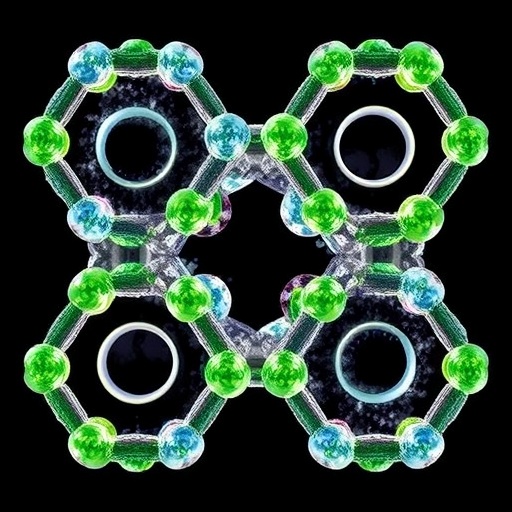In the global quest to mitigate the accelerating climate crisis, capturing carbon dioxide (CO2) efficiently and sustainably from the atmosphere remains a cornerstone challenge. A recent groundbreaking study led by Liu, T., Qu, H., and Harding, S.D., published in Nature Chemistry (2025), unveils an innovative approach that harnesses computational chemistry to design novel organic macrocycles tailored for selective CO2 capture even under humid conditions. This investigation introduces a transformative bottom-up methodology that could redefine the future of carbon capture technologies, addressing longstanding limitations faced by existing materials in real-world environments.
Traditional carbon capture frameworks often struggle with the presence of moisture, which severely hampers CO2 adsorption efficiency. Many adsorbents falter when water molecules compete or interfere with CO2 binding sites, leading to reduced selectivity and capacity. The work by Liu and colleagues elegantly circumvents this problem by focusing on organic macrocycles—ring-shaped molecules whose internal cavities can be synthetically engineered to offer precise shape and functional group complementarity with CO2 molecules. This architectural control enables these macrocycles to selectively bind CO2 over water, a crucial advantage for practical deployment in humid environments such as flue gas streams or ambient air.
The team’s approach revolves around leveraging advanced computational tools that enable a bottom-up design process—starting from basic molecular building blocks and predicting their assembly into macrocycles with desired properties. By combining quantum chemical calculations, molecular dynamics simulations, and machine learning algorithms, they screened thousands of potential structures to identify candidates that maximize CO2 affinity, stability, and shape selectivity. This computational-first strategy accelerates discovery, sidestepping traditional trial-and-error synthetic methods that are costly and time-intensive.
One of the core innovations revealed in the study is the capacity to tune the size, shape, and electronic environment of these macrocycles to optimize interactions with CO2 molecules. The research highlights how subtle modifications in cavity dimensions and functional groups enhance van der Waals forces and electrostatic attractions specific to CO2, while concurrently reducing competitive adsorption of water molecules. These effects are critical because they ensure that the CO2 capture process remains efficient without requiring energy-intensive drying steps, thus improving overall sustainability.
Moreover, the designed macrocycles exhibit remarkable chemical and thermal stability, two prerequisites for industrial viability. The computational analysis demonstrated that these organic rings can withstand humid conditions and elevated temperatures commonly encountered during post-combustion capture, maintaining their selective binding capacity over multiple adsorption-desorption cycles. This resilience is vital for scaling the technology beyond laboratory conditions into operational carbon capture units.
The study also delves into understanding the fundamental molecular recognition mechanisms underpinning the shape selectivity observed. Detailed simulations reveal that CO2 molecules adopt specific orientations within the macrocycle cavities, guided by complementary geometries and optimal charge distributions. This selective fitting mirrors biological processes, where enzymes and receptors exhibit high specificity through shape complementarity, representing an elegant biomimetic insight applied to environmental technology.
Another compelling aspect of this research lies in its implications for modular design. Since the macrocycles are built from discrete molecular units, their composition can be systematically varied to tailor performance parameters for different applications. For instance, modifying peripheral substituents can adjust hydrophobicity, further enhancing performance in variable humidity settings. This adaptability indicates a pathway toward creating a versatile library of materials that can be fine-tuned for diverse carbon capture scenarios.
While experimental validation remains a critical next step, preliminary syntheses reported by the team confirm the feasibility of creating these macrocycles. Early measurements align well with computational predictions, showcasing CO2 uptakes that outperform conventional porous materials and amine-based sorbents under moist conditions. This synergy between theory and practice underscores the power of a computationally directed approach to materials design, promising rapid translation from concept to application.
Environmental scientists and chemical engineers alike are poised to benefit from these insights, which offer a roadmap to overcoming major bottlenecks in carbon capture technologies. By integrating computational chemistry with synthetic strategy, the study paves the way for more efficient, selective, and robust materials that could be deployed at scale to capture anthropogenic CO2 emissions—an essential component of global decarbonization efforts.
From a broader perspective, the ability to capture CO2 selectively in humid environments also opens doors for direct air capture (DAC) technologies that operate under ambient atmospheric conditions. The engineered macrocycles’ selective affinity amid high moisture levels could significantly advance DAC’s viability, enabling carbon removal from ambient air outside of industrial point sources—a critical step toward negative emissions.
Furthermore, the approach’s modularity and design flexibility hint at future multifunctional materials capable of simultaneous pollutant capture or catalytic transformation of CO2. By expanding the functional scope of these macrocycles, researchers may unlock new pathways for converting trapped carbon dioxide into valuable chemicals or fuels, thus closing the carbon loop in innovative ways.
The methodology behind this study exemplifies the convergence of computational power, synthetic chemistry, and environmental science in addressing one of humanity’s most pressing challenges. It reflects a paradigm shift where rational design supersedes empirical guesswork, enabling rapid progress and minimizing resource waste—a model likely to become standard across materials science disciplines.
In conclusion, the bottom-up computational design of shape-selective organic macrocycles stands as a landmark achievement that could revolutionize CO2 capture technology. By tackling the critical issue of humidity interference, delivering stability and selectivity through precise molecular engineering, and providing a versatile platform for tailored functionalities, Liu and colleagues chart a promising course for future carbon management solutions. As carbon capture demands intensify globally, innovations like these will be indispensable tools in humanity’s arsenal against climate change.
Subject of Research: Bottom-up computational design of organic macrocycles for selective CO2 capture under humid conditions.
Article Title: Bottom-up computational design of shape-selective organic macrocycles for humid CO2 capture.
Article References:
Liu, T., Qu, H., Harding, S.D. et al. Bottom-up computational design of shape-selective organic macrocycles for humid CO2 capture. Nat. Chem. (2025). https://doi.org/10.1038/s41557-025-01873-1
Image Credits: AI Generated




